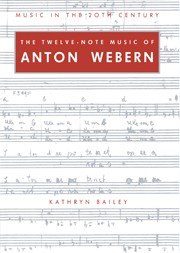Book contents
- Frontmatter
- Contents
- Acknowledgements
- Conventions in the text
- Introduction
- PART I Row and canon
- PART II The instrumental music
- PART III The music with voices
- Conclusion
- Appendices
- I A comparison of row characteristics
- II Matrices
- III Row analyses (1)
- IV Row analyses (2)
- V A note on Webern's graces
- Notes
- Glossary
- Chronological worklist
- Select bibliography
- Index
IV - Row analyses (2)
Published online by Cambridge University Press: 23 December 2009
- Frontmatter
- Contents
- Acknowledgements
- Conventions in the text
- Introduction
- PART I Row and canon
- PART II The instrumental music
- PART III The music with voices
- Conclusion
- Appendices
- I A comparison of row characteristics
- II Matrices
- III Row analyses (1)
- IV Row analyses (2)
- V A note on Webern's graces
- Notes
- Glossary
- Chronological worklist
- Select bibliography
- Index
Summary
I decided to include the following analyses only after considerable hesitation, since the published assignment of a number to every note in all of the pieces seemed to me initially to be the sort of tedious compendium of unfiltered data that too frequently passes for analysis but is nearer to the production of telephone directories. There are too many articles that profess to offer an analysis or explanation but in fact simply list events with exhaustive thoroughness.
However, as I inspected some of the available row analyses, in formats ranging from photocopies of the author's working score containing his personally executed and often illegible pencil lines, arrows and balloons (the American way) to pages of lists of numbers followed by names of instruments, in paragraph form (the German way), I began to realize two things: that many of these people had analysed the works incorrectly and as a consequence found anomalies that do not exist, and that it was the format, not the information itself, that was responsible for my feeling that the considerable time spent wading through them was essentially time wasted. As I began to set down my own analyses in chart form I realized that if presented in some organized fashion the charts themselves can be useful, bringing repetitions, symmetries and various other relationships into focus visually. It is in the hope, then, of correcting existing errors in analysis, and in addition of providing some enlightment of a visual sort, that I offer the following charts. I have tried to preserve the formal outlines so that these charts can be used in conjunction with the analyses in Appendix III.
- Type
- Chapter
- Information
- The Twelve-Note Music of Anton WebernOld Forms in a New Language, pp. 354 - 409Publisher: Cambridge University PressPrint publication year: 1991

